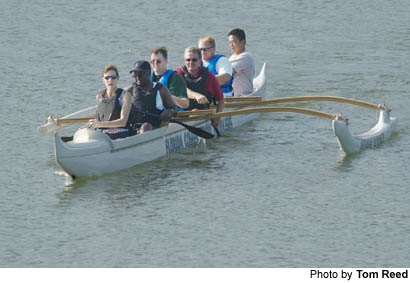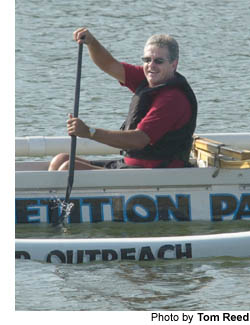
August 21, 2001 — The wheelchair could have belonged to anyone.
It sat alone and empty on a dock, and shifted slightly each time Lake Lanier swelled beneath the platform’s wooden planks.
In the background, was the finish tower from the paddling and rowing events of the 1996 Olympic Games. On the water, was the wheelchair’s owner, one of six people paddling an outrigger canoe.
Some of the bodies in the canoe were abled. Some were disabled. It was impossible to tell which was which.
When the boat returned, some paddlers stood up and stepped on out. Xavier Major waited to be lifted and helped back into his wheelchair — Major’s mode of transportation since a gunshot wound paralyzed him from the waist down eight years ago.
“I may need a little assistance getting in the boat, but once I’m on the water, I’m just as equal as the rest of the people in the boat, as far as I’m concerned,” said Major, 30, of Rochester, N.Y., who has been paddling outrigger canoes for three years.
Major was in Gainesville for the demonstration events in outrigger canoeing at the United States Canoe Association (USCA) National Championships in early August — and he was part of history. For the first time, an outrigger canoe manned entirely by athletes with disabilities powered its way down a race course.
And that made Jan Whitaker cry. Her dream of making outrigger canoe an official event in the Paralympic Games was several paddle strokes closer to becoming a reality.
“I can’t think of a more appropriate venue for this to take place on,” Whitaker said, sunglasses hiding her tears. “The place where the Olympics were held. This is overwhelming. This is a very emotional experience.”
Whitaker is an avid paddler and retired physical education teacher from West Henrietta, N.Y., a Rochester suburb. Four years ago, she made getting outriggers in the Paralympics her “new goal in life.”
It all started in 1997, when one of Whitaker’s students — a 9-year-old disabled girl — first sat inside an outrigger canoe.
“It was her expressions of enthusiasm that really sparked my enthusiasm,” said Whitaker, 58, a former national champion marathon canoeist. “I know the joy of competition. I know the joy of camaraderie with other paddlers. I just feel that this should be an opportunity available to people with disabilities, as well.
“It’s just a mission that I feel that I have to carry out.”
Whitaker joined forces with the Rochester Rehabilitation SportsNet program, and has since had athletes with all sorts of physical disabilities — spinal cord injuries, cerebral palsy, brain injuries, blindness, amputations, multiple sclerosis, spina bifida — paddling outrigger canoes on the Genesee River.
During the USCA nationals, Rochester SportsNet and The Rehabilitation Institute of Northeast Georgia Medical Center offered a clinic for area recreational, physical and occupational therapists outlining how outrigger canoeing can be used as a therapy tool.
The Rehabilitation Institute, along with the Lanier Canoe & Kayak Club, is in the process of trying to raise the $10,000 or so it would take to purchase an outrigger canoe for therapeutic and competitive use on Lake Lanier.
Popular in the South Pacific, outrigger canoes can be nearly 50-feet long and feature a large float extended outboard, parallel to the craft, which provides stability.
“When you get in there, the disability kind of goes away,” Andy Whitener, director of The Rehabilitation Institute, told me. “The canoes are deep. One of the reasons it works so well for people with disabilities is because it’s so secure. It’s not like a kayak where you’re basically sitting on top of the water, and if you lean at all, you fall over.”
As one who has tipped a kayak a time or two, I was anxious to give the odd-looking outrigger a try. And I found that it’s possible to stay relatively dry inside one — unless, of course, you happen to be in the losing boat. Then it’s customary for the winners to paddle water all over you.
 “Y’all got a little cooled off, didn’t you?” Gainesville’s Mike Eberhardt said to me with a chuckle after his boat defeated — and then doused — mine.
“Y’all got a little cooled off, didn’t you?” Gainesville’s Mike Eberhardt said to me with a chuckle after his boat defeated — and then doused — mine.
A later run in the outrigger found Eberhardt and I assigned to the same boat. I sat directly behind him. And we matched each other stroke for stroke.
That Eberhardt lost the use of his legs last Thanksgiving Day — he fell 30-feet from a deer-hunting stand — didn’t matter much out on the water. In fact, it didn’t matter at all.
“This is neat,” said Eberhardt, 47, happy to find an activity he could participate in with his wife and three daughters. “That’d be a lot of fun, I think.”
Eberhardt, who later joined Major in that history-making boat, said he’d love to see more activities — like outrigger canoeing — offered to disabled athletes in Northeast Georgia.
“It’s good to get disabled people out of the house as much as they can,” Eberhardt said. “It’s just so easy to wake up in the morning and not want to do anything. You’re in a different world, and you’ve got to really push yourself to get out and do things. If it’s not accessible, you won’t get out and pursue it.”
Just nine months after his accident, Eberhardt is upbeat. His therapists say he is motivated to try anything.
“It’s gotten easier,” Eberhardt said. “The first couple months were tough. They were really, really tough mentally. Physically it was tough, but mentally it was tougher. I felt like I was shut out from the outside world.
“But I’m coming around,” Eberhardt added, looking out toward Lake Lanier. “Yeah, I’m coming around.”
